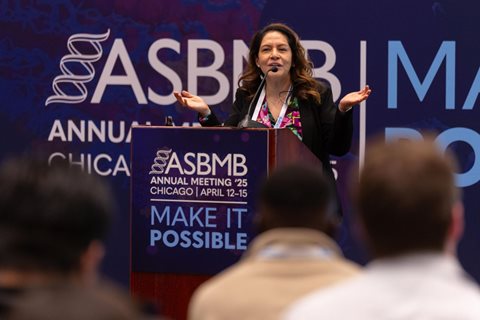How to write a killer abstract in 10 sentences
The experiments were carefully designed. The data have been meticulously collected. The figures have been expertly prepared. The results are beautiful! All that stands between you and presenting your science at the American Society for Biochemistry and Molecular Biology 2022 annual meeting is writing an abstract. But where do you begin? How do you write an abstract that will get your science noticed?

Each day, we are bombarded with a deluge of information, each item vying for our attention. We rely on eye-catching headlines to draw us toward the content that might enrich our lives. In the scientific arena, we rely on abstracts to provide snapshots of studies that may be relevant to us. Abstracts are a crucial filter that helps us to gauge quickly which reports must go to the top of our to-read list.
Previously, I’ve written how to present a killer research seminar by pretending you are serving the audience a three-course meal at a mystery dinner theater. The appetizer introduces the scientific puzzle as a mystery. The main course is composed of the experiments that uncovered clues. The dessert course satisfies the audience by revealing how the clues addressed the mystery.
Below, I outline how this formula can be adapted to craft an irresistible abstract that will make people hungry to see more of your work.
Sentences 1-2. Set the stage.
The beginning of a killer abstract must convey the scientific question that keeps you up at night and why. Use the first couple of sentences to describe succinctly the most salient features of the phenomenon you are investigating and, if applicable, how it is relevant to a medical or environmental problem. The stage you set should draw attention to a gap in our knowledge that you are attempting to fill.
Sentence 3. State the mystery.
The next sentence is a clear and focused hypothesis framed as a question — this represents the mystery your study aims to solve. It should be an interesting and intuitive question derived from the background information in your introductory sentences. If the reader cannot guess your hypothesis after reading that introduction, you haven’t set the stage well enough.
Sentences 4-8. Describe your detective work.
This section is the heart of the experimental effort you used to gather clues relating to the mystery. Explain the case as Sherlock would to Watson, concisely mentioning the rationale and techniques used to unearth the clues.
Like discriminating detectives, scientists demand precision. If you are vague, your poor reader is forced to wonder what you mean. For example, the statement “Transcript levels were greatly altered in the knockout” leaves people with questions: How many transcripts? How were they altered, and by how much? Instead, write, “We determined that 75% of transcripts increased twofold or more in the knockout.”
You do not want to disrupt a compelling story by going off on distracting tangents. You need not mention every experiment you completed, only those that provide the most important clues needed to answer the question.
Sentence 9. Solving the mystery.
This is the sentence the audience has been waiting for, but if you’ve laid out the clues adequately, they should be able to deduce the conclusion themselves. This sentence should state clearly how your findings contribute to solving the mystery you posed in the introduction.
It is important to note that you don’t need to solve the mystery completely to make a compelling story. Negative data or replicative studies are vital to the scientific enterprise, providing critical clues for resolving biological questions.
Sentence 10. So what?
The final sentence of your abstract should remind the reader why your findings are important — for example, in terms of providing new insights into behavior, mitochondrial function or gene expression. If applicable, mention how these findings may facilitate the development of new therapies for a disease.
In summary, a killer abstract tells a story by framing your scientific study as a mystery. As with all good stories, you’ll also want to devise an alluring or clever title to capture attention.
Remember: Conference organizers and participants have many abstracts on their plates. Be sympathetic to their plight and make yours enticing and easy to digest. You can keep it simple by avoiding technical jargon wherever possible, defining esoteric terms that must be used, and eliminating unnecessary words or phrases. Avoid the temptation to add extraneous information or research results that are superfluous to your story.
Finally, take advantage of the many resources available to assist writers. Be sure to use tools for checking spelling and grammar. Make certain that you include relevant keywords in your abstract; many people use them to scan the abstract book.
And don’t forget the most important resource of all — readers. Don’t submit an abstract before taking it on a few test spins by getting others inside and outside your field to read it. If they are not intrigued, you need to go back to the kitchen and cook up a better dish.
Enjoy reading ASBMB Today?
Become a member to receive the print edition four times a year and the digital edition monthly.
Learn moreFeatured jobs
from the ASBMB career center
Get the latest from ASBMB Today
Enter your email address, and we’ll send you a weekly email with recent articles, interviews and more.
Latest in Careers
Careers highlights or most popular articles

Building the blueprint to block HIV
Wesley Sundquist will present his work on the HIV capsid and revolutionary drug, Lenacapavir, at the ASBMB Annual Meeting, March 7–10, in Maryland.

Upcoming opportunities
Present your research alongside other outstanding scientists. The #ASBMB26 late-breaking abstract deadline is Jan. 15.

Designing life’s building blocks with AI
Tanja Kortemme, a professor at the University of California, San Francisco, will discuss her research using computational biology to engineer proteins at the 2026 ASBMB Annual Meeting.

Upcoming opportunities
#ASBMB26 late-breaking abstract submission opens on December 8. Register by Jan. 15 to get the early rate on our Annual Meeting.

Make your abstract stand out
Ensure your research is impossible to overlook. Get quick, practical reminders for crafting an abstract that attracts readers and helps you build connections at the conference.

Inside industry postdocs
As more Ph.D. scientists look beyond academia, industry postdocs offer a new kind of training, where mentorship meets mission-driven research. Fellows at Pfizer and Genentech share how these programs prepare them to translate discovery into impact.

